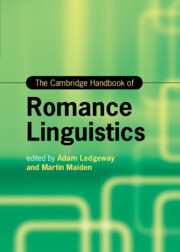Book contents
- The Cambridge Handbook of Romance Linguistics
- Cambridge Handbooks in Language and Linguistics
- The Cambridge Handbook of Romance Linguistics
- Copyright page
- Dedication
- Contents
- Figures
- Tables
- Contributors
- Abbreviations
- 1 Data, Theory, and Explanation: The View from Romance
- Part One What Is a Language?
- Part Two Phonetics and Phonology
- 5 Structure of the Syllable
- 6 Sandhi Phenomena
- 7 Effects of Stress
- 8 The Notion of the Phoneme
- 9 Typologically Exceptional Phenomena in Romance Phonology
- Part Three Morphology
- Part Four Syntax
- Part Five Semantics and Pragmatics
- Part Six Language, Society, and the Individual
- Index
- References
9 - Typologically Exceptional Phenomena in Romance Phonology
from Part Two - Phonetics and Phonology
Published online by Cambridge University Press: 23 June 2022
- The Cambridge Handbook of Romance Linguistics
- Cambridge Handbooks in Language and Linguistics
- The Cambridge Handbook of Romance Linguistics
- Copyright page
- Dedication
- Contents
- Figures
- Tables
- Contributors
- Abbreviations
- 1 Data, Theory, and Explanation: The View from Romance
- Part One What Is a Language?
- Part Two Phonetics and Phonology
- 5 Structure of the Syllable
- 6 Sandhi Phenomena
- 7 Effects of Stress
- 8 The Notion of the Phoneme
- 9 Typologically Exceptional Phenomena in Romance Phonology
- Part Three Morphology
- Part Four Syntax
- Part Five Semantics and Pragmatics
- Part Six Language, Society, and the Individual
- Index
- References
Summary
This chapter on Romance phonology reviews several phenomena that can be qualified as typologically rare. Some of the phenomena examined are rarely documented within Romance but are relatively common in other language families, while others are hardly attested in the world’s languages but are present to some degree in Romance. Their relative frequency across languages and geographical distribution have been assessed with the help of three online databases that are publicly available: PHOIBLE, WALS, and the World Phonotactics Database. In addition, the challenges that these phenomena represent for phonological theory are also briefly considered. The topics examined in this chapter concern (i) phoneme inventories; (ii) syllable structure, with a focus on consonantal clusters; (iii) segmental processes involving glides, nasal place neutralization, lenition and fortition, and metathesis, among others; and (iv) issues at the morphology–phonology interface involving suprasegmentals.
Keywords
- Type
- Chapter
- Information
- The Cambridge Handbook of Romance Linguistics , pp. 292 - 318Publisher: Cambridge University PressPrint publication year: 2022



